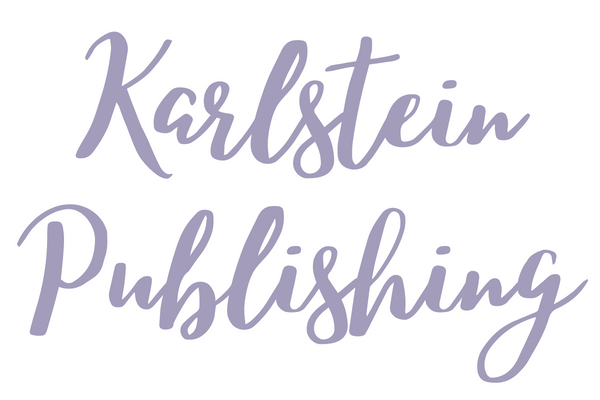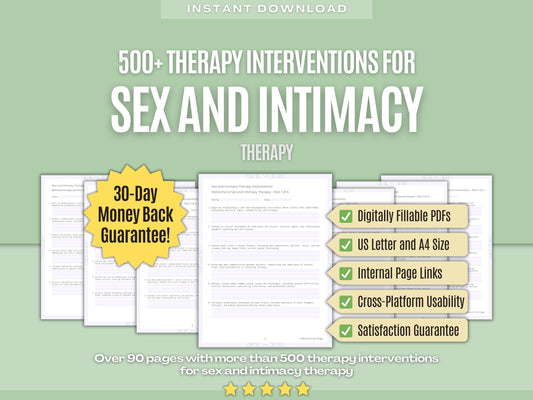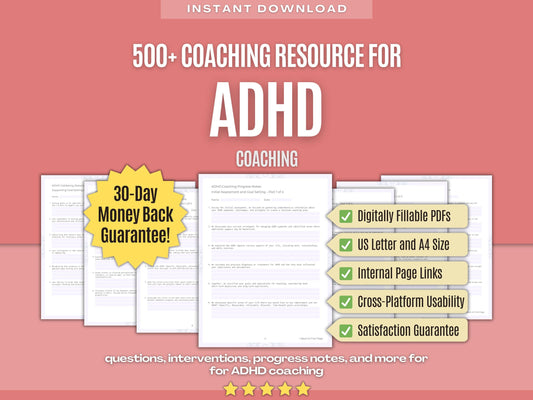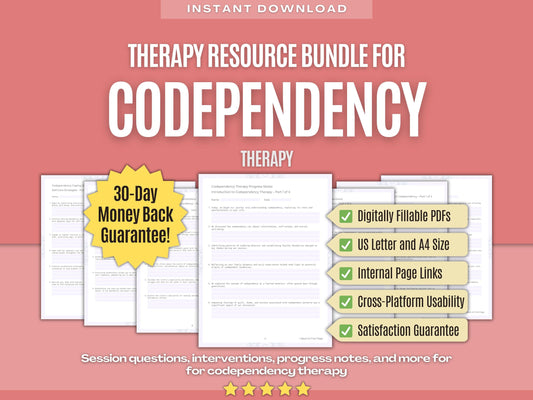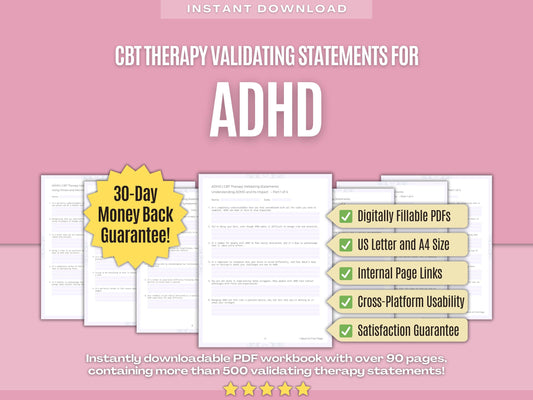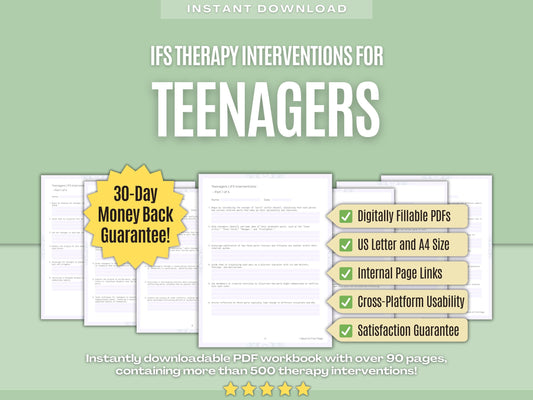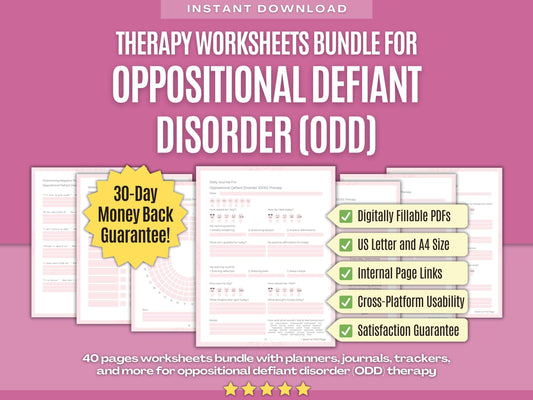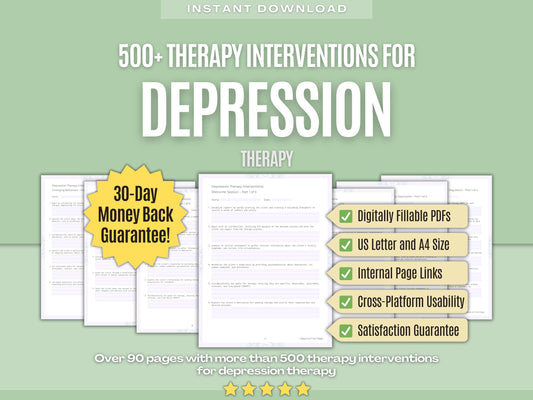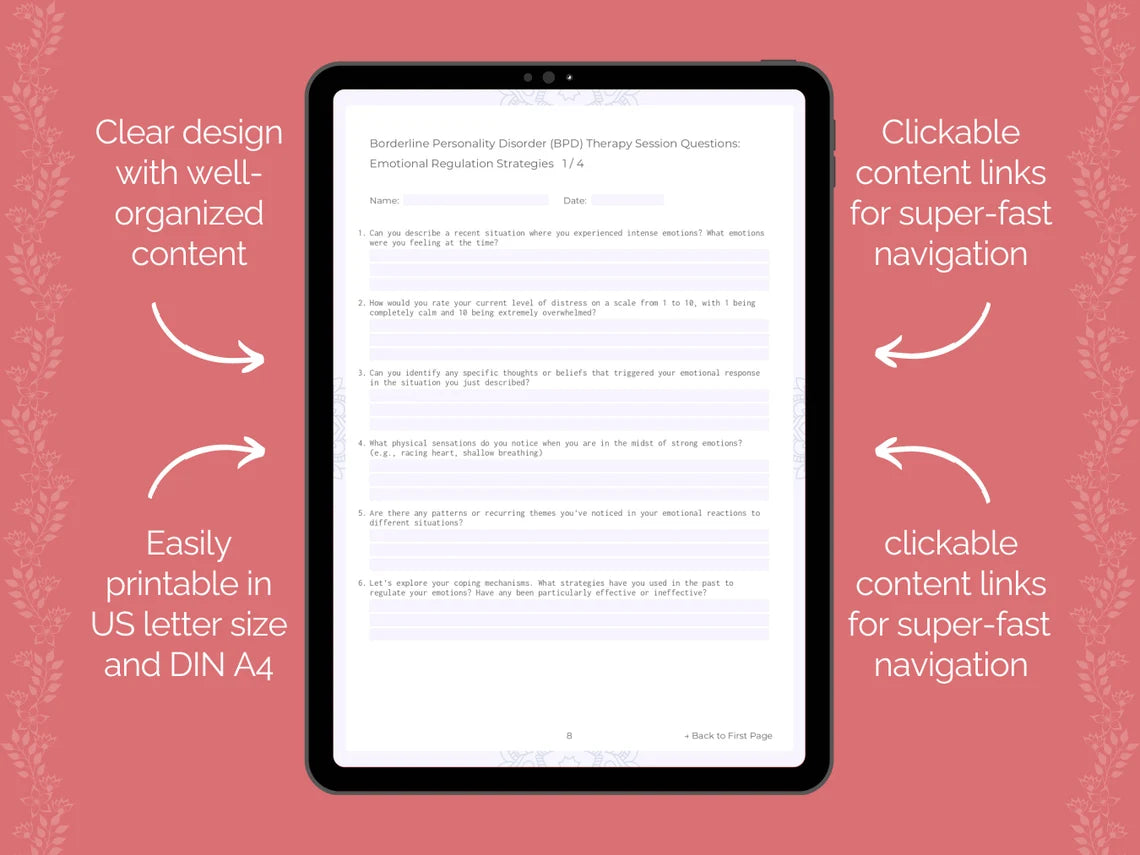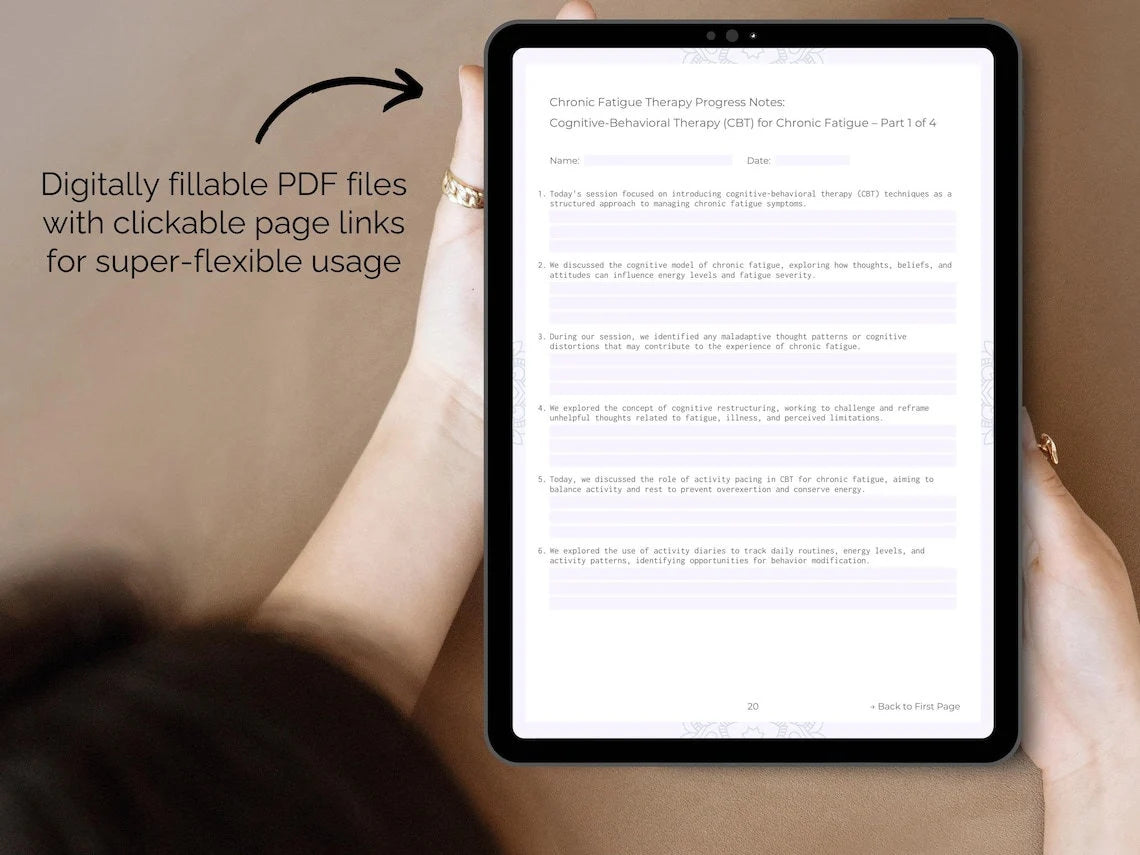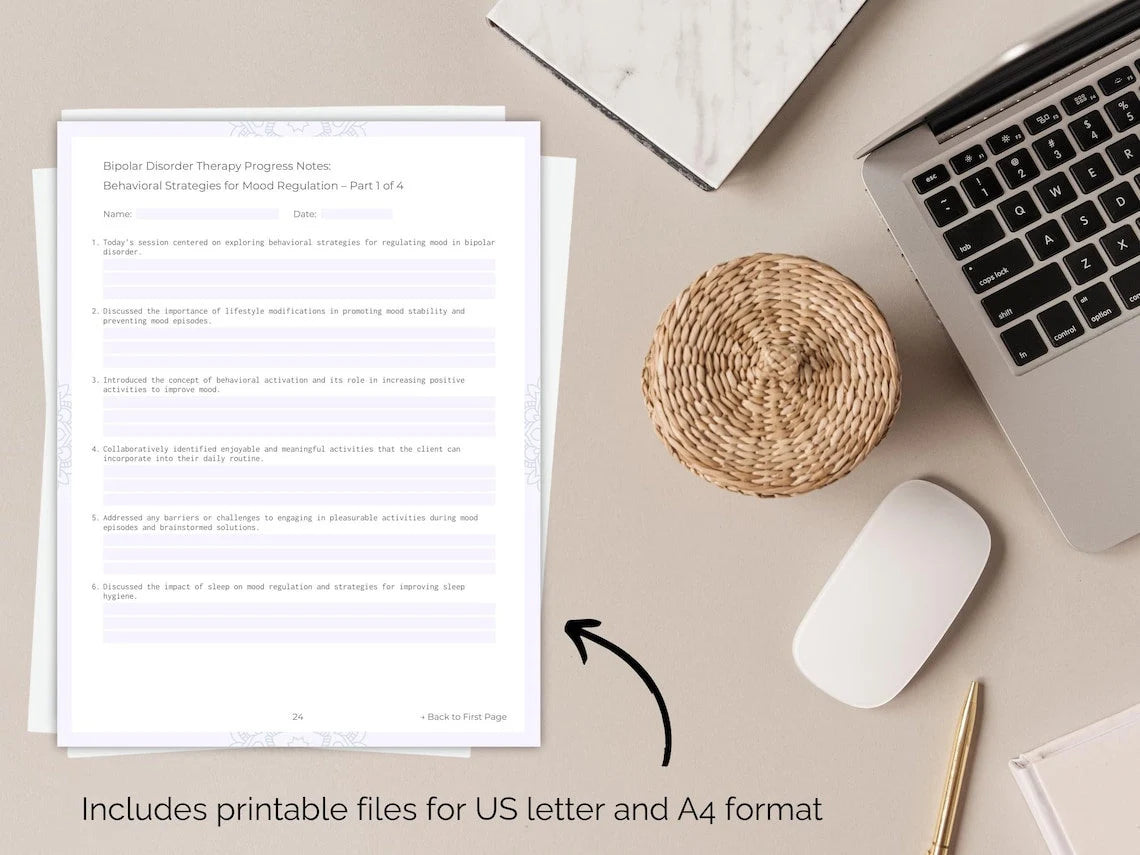Elevate Your Therapy and Guide Your Clients to Inner Healing with Our Attention Deficit Disorder (ADD) Therapy Interventions! ✨
1. Starting ADD Therapy
- Begin by creating a warm and inviting atmosphere to help the client feel comfortable and at ease.
- Establish rapport with the client by actively listening to their concerns and demonstrating empathy and understanding.
- Collaborate with the client to set clear and achievable goals for therapy, tailored to their individual needs and priorities.
- Introduce psychoeducation materials, such as articles, books, or videos, to provide further insight into ADD and its treatment.
- Discuss strategies for improving time management and organizational skills, such as using planners, calendars, or digital apps.
- Explore the role of exercise and physical activity in managing ADD symptoms and improving overall well-being.
- Teach relaxation techniques, such as deep breathing or progressive muscle relaxation, to help the client manage stress and anxiety.
- Collaborate with the client to identify potential accommodations or modifications in academic or work settings.
- Address any concerns or questions the client may have about medication options for managing ADD symptoms.
- Discuss the impact of ADD symptoms on the client's relationships and daily life, and explore ways to improve social functioning.
- Encourage the client to track their progress and monitor changes in symptoms or functioning over time.
2. ADD Psychoeducation
- Begin by providing a comprehensive overview of Attention Deficit Disorder (ADD), including its symptoms, diagnostic criteria, and prevalence in the population.
- Discuss the various subtypes of ADD, such as predominantly inattentive presentation, predominantly hyperactive-impulsive presentation, and combined presentation, to help clients understand how symptoms may manifest differently.
- Provide information about the potential impact of ADD on academic, occupational, and social functioning, highlighting challenges that individuals with ADD may face in these areas.
- Explore the role of genetics and family history in the development of ADD, helping clients understand potential risk factors and genetic predispositions.
- Educate clients about evidence-based treatments for ADD, including medication management, behavioral therapy, cognitive-behavioral therapy, and organizational skills training.
- Introduce strategies for managing ADD symptoms without medication, such as developing effective coping skills, implementing organizational strategies, and establishing healthy lifestyle habits.
- Teach clients about the concept of executive functioning and its role in regulating cognitive processes such as attention, inhibition, and working memory.
- Discuss the importance of self-care and stress management for individuals with ADD, emphasizing the role of exercise, mindfulness, relaxation techniques, and adequate sleep in maintaining overall well-being.
- Encourage clients to actively engage in their treatment process, asking questions, seeking support, and advocating for their needs.
- Discuss the potential impact of ADD on relationships, family dynamics, and social interactions, providing guidance for improving communication and interpersonal skills.
- Discuss strategies for building resilience and coping with setbacks or difficulties associated with ADD, emphasizing the importance of perseverance and self-compassion.
3. Mindfulness for ADD
- Begin by introducing the concept of mindfulness and its potential benefits for individuals with Attention Deficit Disorder (ADD), explaining that mindfulness involves paying attention to the present moment with openness, curiosity, and acceptance.
- Discuss the neuroscience of mindfulness, explaining how regular mindfulness practice can lead to changes in brain structure and function that support enhanced cognitive functioning and emotional resilience.
- Guide clients in practicing mindfulness exercises during therapy sessions, providing gentle encouragement and support as they learn to cultivate present-moment awareness.
- Introduce the practice of mindfulness meditation, guiding clients through guided meditation sessions focused on cultivating qualities such as kindness, compassion, and self-acceptance.
- Teach clients strategies for integrating mindfulness into their work or academic routines, such as taking mindful breaks, setting mindful intentions for the day, or using mindfulness apps or reminders to stay present.
- Discuss common barriers to mindfulness practice, such as restlessness, boredom, or self-judgment, and work collaboratively with clients to develop strategies for overcoming these obstacles.
- Discuss the potential benefits of mindfulness for managing stress and anxiety, helping clients develop a repertoire of mindfulness-based stress reduction techniques, such as progressive muscle relaxation or loving-kindness meditation.
- Encourage clients to establish a regular mindfulness practice outside of therapy sessions, providing guidance on setting realistic goals, finding resources, and troubleshooting challenges that arise.
- Explore the connection between mindfulness and creativity, discussing how mindfulness practices can enhance creative thinking, problem-solving skills, and innovation in various domains of life.
- Explore the relationship between mindfulness and self-regulation, discussing how mindfulness practices can help individuals become more aware of their impulses, regulate their emotions, and make healthier choices in daily life.
- Encourage clients to cultivate a non-judgmental attitude toward their experiences during mindfulness practice, fostering an attitude of curiosity, openness, and acceptance toward whatever arises in the present moment.
4. Dialectical Behavior Therapy (DBT) for ADD
- Begin by introducing the principles of Dialectical Behavior Therapy (DBT) and how they can be adapted to address the unique needs and challenges of individuals with Attention Deficit Disorder (ADD).
- Collaborate with clients to identify specific areas of difficulty related to ADD, such as impulsivity, emotional dysregulation, or difficulty managing relationships, and prioritize these areas for intervention.
- Guide clients in practicing mindfulness exercises during therapy sessions, such as mindful breathing, body scans, or mindful eating, to help them cultivate present-moment awareness and reduce impulsivity and distractibility.
- Collaboratively develop a crisis plan with clients, outlining specific strategies and resources they can use to manage crises related to ADD symptoms, such as overwhelming emotions, impulsivity, or interpersonal conflicts.
- Discuss the concept of dialectics with clients, helping them recognize and accept the inherent contradictions and tensions in their experiences, and work towards finding a balance between acceptance and change.
- Explore the impact of ADD symptoms on self-esteem and self-image, and work with clients to challenge negative beliefs and develop a more compassionate and accepting attitude towards themselves.
- Explore the concept of radical acceptance with clients, encouraging them to accept their current reality without judgment or resistance, and focus on making positive changes moving forward.
- Discuss the potential benefits of medication for managing ADD symptoms, and collaborate with clients to explore their options and make informed decisions about medication management in conjunction with DBT skills.
- Explore the role of self-soothing techniques in managing emotional distress and promoting relaxation, such as engaging in pleasurable activities, practicing self-compassion, or using sensory-based strategies to soothe the nervous system.
- Collaboratively develop a self-care plan with clients, incorporating activities such as exercise, relaxation exercises, hobbies, and social support to promote overall well-being and resilience.
- Explore the concept of non-judgmental observation with clients, helping them cultivate an attitude of curiosity, openness, and acceptance towards their thoughts, emotions, and experiences.
5. Interpersonal Therapy (IPT) for ADD Challenges
- Begin by exploring the client's interpersonal relationships, identifying patterns of interaction that may contribute to ADD challenges.
- Teach communication skills tailored to managing ADD symptoms during social interactions, such as active listening and maintaining focus.
- Utilize role-playing exercises to practice social skills in simulated scenarios, allowing the client to develop confidence and competence.
- Explore past experiences of rejection or social difficulties, working through unresolved emotions and building resilience.
- Foster empathy and perspective-taking by encouraging the client to consider others' viewpoints and feelings.
- Practice assertiveness skills to express needs and boundaries effectively while respecting the rights of others.
- Address conflicts within relationships by facilitating open communication and problem-solving strategies.
- Explore the impact of medication or other treatments on interpersonal functioning, addressing any concerns or side effects.
- Collaborate with the client to develop strategies for managing time and commitments in social contexts, avoiding overwhelm.
- Offer psychoeducation to friends and family members to increase understanding and support for the client's challenges.
- Foster a growth mindset by reframing setbacks as opportunities for learning and growth in social interactions.
6. Emotion-Focused Therapy (EFT) for ADD
- Begin by helping the client identify and articulate their emotions related to their experiences with ADD, creating a foundation for emotional awareness and expression.
- Explore the underlying emotional needs and vulnerabilities that may contribute to the client's difficulties with attention and self-regulation.
- Foster a compassionate and nonjudgmental stance towards the client's emotional experiences, creating a safe space for vulnerability and exploration.
- Encourage the client to practice emotional regulation strategies such as mindfulness, deep breathing, and progressive muscle relaxation to manage intense emotions.
- Facilitate emotion-focused interventions aimed at enhancing emotional expression and communication within the client's interpersonal relationships.
- Collaboratively develop personalized emotion-focused coping strategies to help the client navigate emotional triggers and stressors associated with their ADD symptoms.
- Validate the client's strengths and adaptive coping mechanisms in managing their emotions within the context of ADD, fostering a sense of self-efficacy and resilience.
- Encourage the client to practice self-compassion and self-care as they navigate the emotional challenges of living with ADD, promoting emotional well-being and resilience.
- Utilize emotion-focused imagery techniques to help the client visualize and process their emotions in a safe and supportive therapeutic environment.
- Integrate elements of mindfulness-based cognitive therapy (MBCT) to help the client cultivate present-moment awareness and acceptance of their emotional experiences.
- Facilitate emotion-focused interventions aimed at resolving unresolved emotional conflicts or traumas that may contribute to the client's ADD symptoms.
7. Psychodynamic Insights for ADD
- Begin by exploring the client's early childhood experiences and attachment dynamics, considering how these early relationships may contribute to the development of ADD symptoms.
- Utilize techniques such as free association and dream analysis to help the client access unconscious thoughts, emotions, and memories related to their experiences with ADD.
- Investigate the client's defense mechanisms and coping strategies, exploring how these unconscious processes may serve to protect against underlying feelings of vulnerability or inadequacy related to ADD.
- Utilize techniques such as transference analysis to help the client gain insight into recurring relational patterns or dynamics that may contribute to their experiences with ADD.
- Investigate the client's patterns of self-sabotage or self-defeating behavior, exploring underlying unconscious motives or fears that may drive these behaviors in the context of ADD.
- Utilize techniques such as ego analysis to help the client gain insight into the underlying psychological structures that govern their thoughts, emotions, and behaviors in relation to their ADD symptoms.
- Investigate the client's patterns of relational intimacy and closeness, exploring how these dynamics may be influenced by underlying fears of rejection or abandonment related to ADD symptoms.
- Utilize techniques such as regression analysis to help the client access memories or emotions from earlier developmental stages, providing opportunities for insight and healing related to their experiences with ADD.
- Investigate the client's experiences of attachment and separation, considering how these early relational dynamics may influence their patterns of emotional regulation and interpersonal relationships in the context of ADD.
- Utilize techniques such as object relations analysis to help the client explore their internalized representations of significant others and their impact on the client's experiences with ADD.
- Investigate the client's experiences of rejection or social marginalization, considering how these experiences may contribute to symptoms of low self-esteem or social withdrawal in relation to ADD.
8. Music Therapy for ADD Focus
- Begin by introducing the concept of music therapy as a tool for enhancing focus and attention in individuals with ADD, emphasizing the rhythmic and melodic elements of music that can engage the brain.
- Encourage the client to engage in rhythmic activities such as drumming or clapping along to a beat, promoting synchronization between mind and body to enhance concentration.
- Guide the client in creating personalized playlists of music that help them focus and concentrate, considering their individual preferences and sensory sensitivities.
- Encourage the client to engage in improvisational music-making, allowing them to express themselves freely and creatively while honing their ability to sustain attention and focus.
- Utilize music-based relaxation techniques such as progressive muscle relaxation or guided meditation to help the client manage stress and anxiety that may interfere with focus and attention.
- Integrate elements of cognitive-behavioral therapy (CBT) into music therapy interventions, using music as a medium for challenging negative thought patterns or cognitive distortions that impede focus and attention.
- Guide the client in exploring the connection between music and movement, incorporating dance or rhythmic exercises to stimulate kinesthetic awareness and promote sustained engagement.
- Encourage the client to engage in music-based mindfulness practices, such as focused listening or toning, to cultivate present-moment awareness and improve attentional control.
- Guide the client in creating personalized music playlists for different activities or environments, such as studying, working, or relaxing, to optimize their ability to maintain focus and productivity throughout the day.
- Utilize music-based imagery rehearsal techniques to help the client mentally prepare for challenging tasks or situations, using music as a catalyst for visualization and positive reinforcement.
- Encourage the client to engage in music-based self-expression activities, such as songwriting or lyric analysis, to process emotions and thoughts that may interfere with focus and attention.
9. Wrapping Up ADD Therapy Sessions
- Reflect on the progress made during the session, acknowledging any insights, breakthroughs, or challenges that arose.
- Validate the client's efforts and contributions to the therapy process, affirming their resilience, courage, and commitment to growth and change.
- Provide psychoeducation or skill-building exercises related to managing ADD symptoms, equipping the client with practical tools and strategies to implement between sessions.
- Explore any insights or themes that emerged during the session, inviting the client to reflect on how these insights may inform their understanding of themselves and their experiences with ADD.
- Offer encouragement and support for the client's ongoing journey with ADD, emphasizing their strengths, resilience, and capacity for growth and adaptation.
- Discuss any changes or adjustments that may be needed in the client's treatment plan, considering new insights, goals, or priorities that have emerged during the session.
- Normalize the challenges of living with ADD, emphasizing that setbacks and difficulties are a natural part of the healing and growth process.
- Encourage the client to practice self-care and self-compassion between sessions, emphasizing the importance of prioritizing their physical, emotional, and mental well-being.
- Validate the client's experiences of empowerment and agency, recognizing their capacity to make meaningful changes in their lives despite the challenges posed by ADD.
- Offer encouragement and support for the client's continued engagement in therapy, emphasizing the importance of maintaining momentum and consistency in their treatment journey.
- Explore the client's goals and aspirations for the future, helping them envision a life that is aligned with their values, priorities, and passions beyond the limitations of ADD.
10. Conclusion of ADD Therapy
- Reflect on the client's journey throughout the course of therapy, acknowledging the progress, insights, and challenges they have experienced along the way.
- Validate the client's efforts and commitment to the therapeutic process, affirming their resilience, courage, and dedication to addressing their ADD challenges.
- Discuss any unresolved issues or lingering concerns the client may have, providing closure and resolution where possible and identifying resources or support systems to address ongoing needs.
- Provide recommendations for continued self-care and personal growth, emphasizing the importance of prioritizing their physical, emotional, and mental well-being.
- Discuss strategies for managing setbacks and challenges that may arise after therapy, empowering the client to navigate future difficulties with resilience and confidence.
- Validate the client's experiences of growth and change, celebrating their progress and accomplishments in therapy and beyond.
- Normalize the process of therapy as a collaborative and iterative journey, emphasizing that progress is not always linear and may involve periods of growth, stagnation, or regression.
- Offer gratitude and appreciation for the client's trust, openness, and willingness to engage in the therapeutic process, affirming the therapeutic relationship as a source of support, healing, and growth.
- Provide closure and closure to the therapeutic relationship, acknowledging the ending of therapy as a natural and necessary step in the client's journey of healing and growth.
- Offer reassurance and encouragement for the client's future endeavors, expressing confidence in their ability to navigate life's challenges with resilience, grace, and authenticity.
- Validate any emotions or reactions the client may be experiencing about the conclusion of therapy, providing space for them to process and express their feelings in a supportive and non-judgmental environment.
We hope that our therapy interventions for Attention Deficit Disorder (ADD) therapy will help you to elevate your therapy practice and guide your clients to inner healing! Do you need more therapy interventions for Attention Deficit Disorder (ADD) therapy? Find them all in our Digital Workbook! Or do you have any questions or suggestions for us? Please feel free to contact us at any time!
